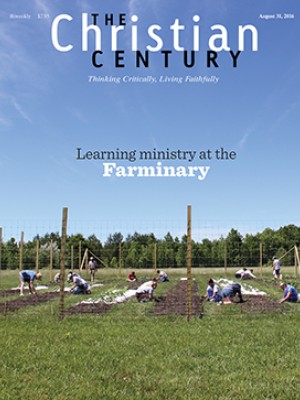Zanzibar historic cathedral restored, featuring center on slave-trade heritage
The land just outside the narrow streets and corridors of Stone Town, Zanzibar, where Christ Church Anglican Cathedral was built, was once a slave market. Now the church stands as a symbol of remembrance to the men, women, and children taken from East Africa and sold into slavery.
After a multiyear project by the Anglican Diocese of Zanzibar—part of the Anglican Church in Tanzania—to restore the cathedral, it will be rededicated later this year or in early 2017.
The cathedral, named a UNESCO World Heritage Site in 2000, also recently opened a heritage center to commemorate the abolition of slavery and to educate people about slavery in its modern forms.
Bishop of Zanzibar Michael Hafidh, whose mother was a Christian and whose father was a Muslim, is especially pleased that the center is “accessible to school children, who are the country’s future leaders,” he wrote in an e-mail. “Telling the story of this dark chapter in the region’s history in an open and factual way will help bridge social and ethnic divides and promote tolerance, reconciliation, and an inclusive society.”
Read our latest issue or browse back issues.
The heritage center will tell the story in English and Swahili of the slave trade in East Africa, beginning with the capture of slaves in places like the Congo, Kenya, and Tanganyika. It details how they worked on spice plantations and were sent abroad on ships from Zanzibar.
The center also describes the legacy that slavery imparted to Zanzibar, an island archipelago with 1.3 million people, 95 percent of them Muslim. Religious minorities include pagans and Hindus. Christians, who make up 2.5 to 3 percent of the population, include Roman Catholics, Anglicans, Lutherans, and Pentecostals.
The history of the slave trade has been taught in Zanzibar in a way that blames Arabs, and Islam by association, wrote Nuhu Sallanya, director for Cultural Heritage Centre, in an e-mail.
“The truth is the slave trade in East Africa involved Arabs, Indians, Africans, and local leaders like chiefs,” he said.
Slavery in East Africa differed from the kind of large-scale plantation slavery in the United States, said Derek Peterson, professor of history and African studies at the University of Michigan and a member of St. Andrew’s Episcopal Church in Ann Arbor.
“In East Africa slaves could also be artisans, they could be businessmen, they could go into jobs of their own and remit a portion of their profits to their owner,” he said. “But they could be very enterprising in their work.”
The heritage center in some ways seeks to set the record straight and promote reconciliation.
“Black Africans could and did become slave owners themselves by becoming Muslims,” Peterson said. “East Africa’s slave economy was a very complicated place in which there wasn’t a clearly defined slave-owning class and neither was there a clearly defined class of who were slaves.”
The slave trade shifted to East Africa after the British parliament ended the Atlantic slave trade in the early 1800s and later positioned navy squadrons off the coast to intercept slaving vessels headed for the New World, driving up the price for slaves, said Peterson. The demand for slave labor was high in the Caribbean and Brazil; the latter country didn’t abolish slavery until the late 19th century.
“Sometimes they were also sold in great numbers to dealers who took them around the Cape of Good Hope bound for Brazil,” Peterson said.
In addition to serving as a memorial to the slaves who were brought to the market, the cathedral also commemorates the work of Scottish explorer and missionary David Livingstone and his efforts to abolish the slave trade.
“The Anglican Church in Zanzibar grew out of a long campaign against the slave trade in East Africa inspired by the rhetoric of David Livingstone,” Peterson said.
The dominant Anglican mission in Zanzibar was called the Universities Mission to Central Africa, due in part to abolitionist work at Oxford and Cambridge, marked by a famous speech in which Livingstone spoke about the degradation of the slave trade, Peterson said.
“Livingstone’s idealistic speech gives rise to a whole mission in UMCA, which is populated by enterprising high-minded Anglican students from Oxford and Cambridge and other British universities,” he said.
Following Livingstone’s speech in the 1870s, the UMCA was launched in Zanzibar and inland in what today is Malawi, where missionaries opened up stations to accommodate freed slaves, some of whom they purchased and others whom they rescued.
“They become the first congregations for Anglican missionaries to preach to and later they become important emissaries of Christianity to other parts of East Africa, and agents of the Anglican mission who preach and translate and work alongside British missionaries in the work of evangelism,” he said.
Anglicanism continued to grow slowly in Zanzibar until the revolution in 1964, when the sultan of Zanzibar was removed from power. The new government took over the Anglican mission’s headquarters as well as the schools and the hospital missionaries had built. The church moved its headquarters to the mainland of Tanzania, and the church’s other buildings on the island, including the cathedral, fell into disrepair, said James Kaleza, assistant diocesan secretary.
In the 1990s a change in government policy allowed the Diocese of Zanzibar to reassume its work on the island. “The diocese was reinaugurated in 2001.”
Today’s Anglicans in Zanzibar trace their roots to emancipated slaves, Kaleza said.
“Most of the Anglicans in Africa are descendants of slaves because their ancestors were those who were brought here to be sold and ended up at the mission,” Kaleza said. “They became the first Anglicans.” —Episcopal News Service





